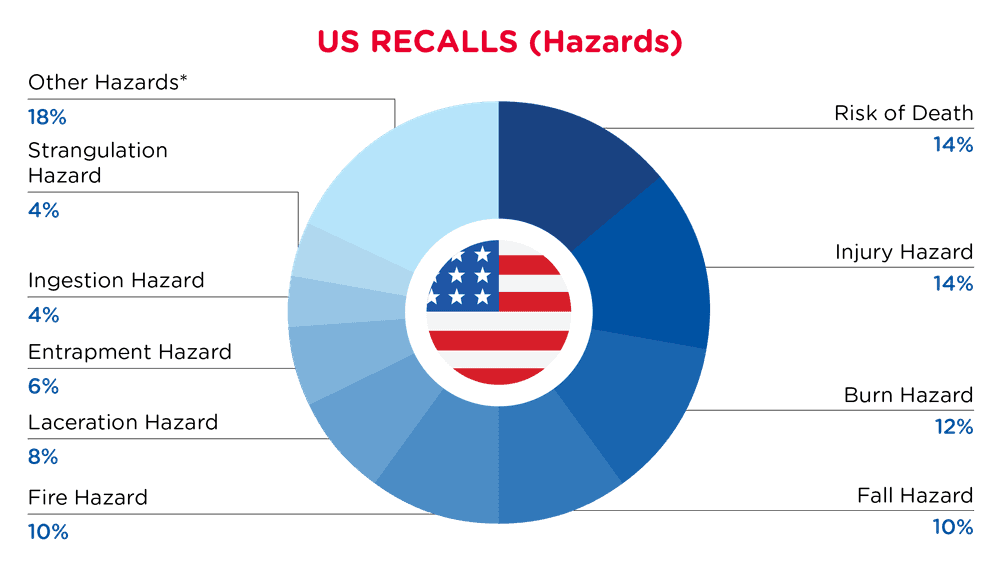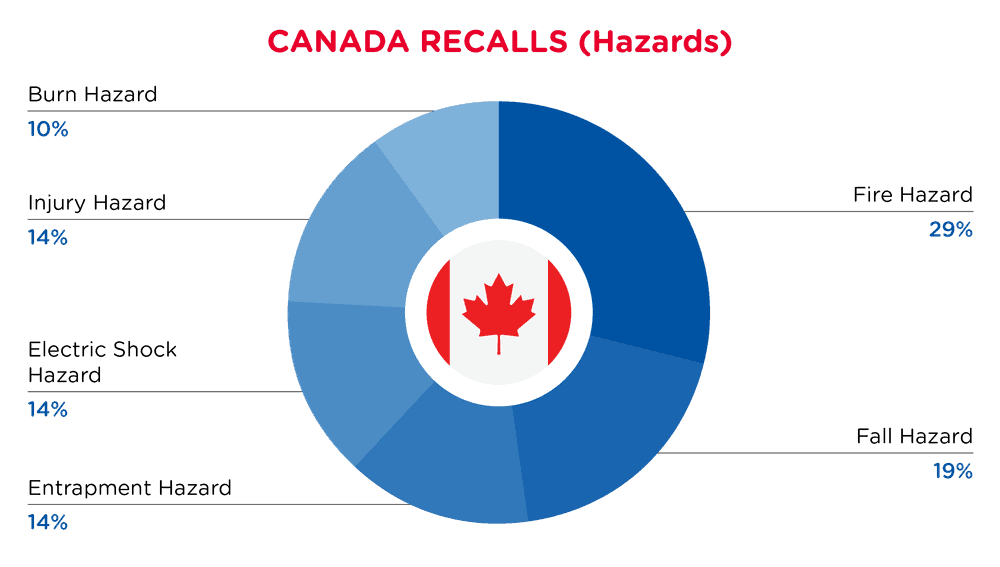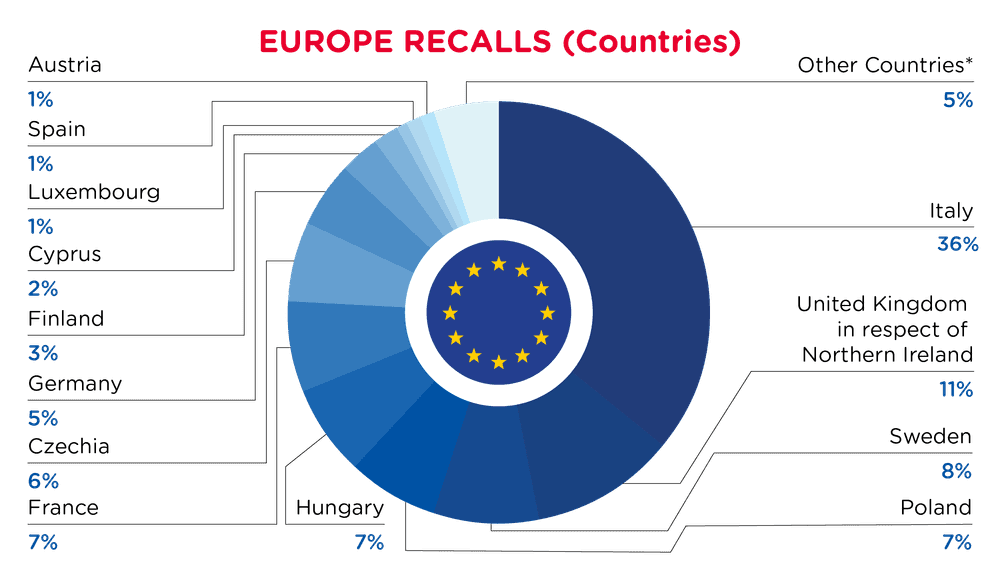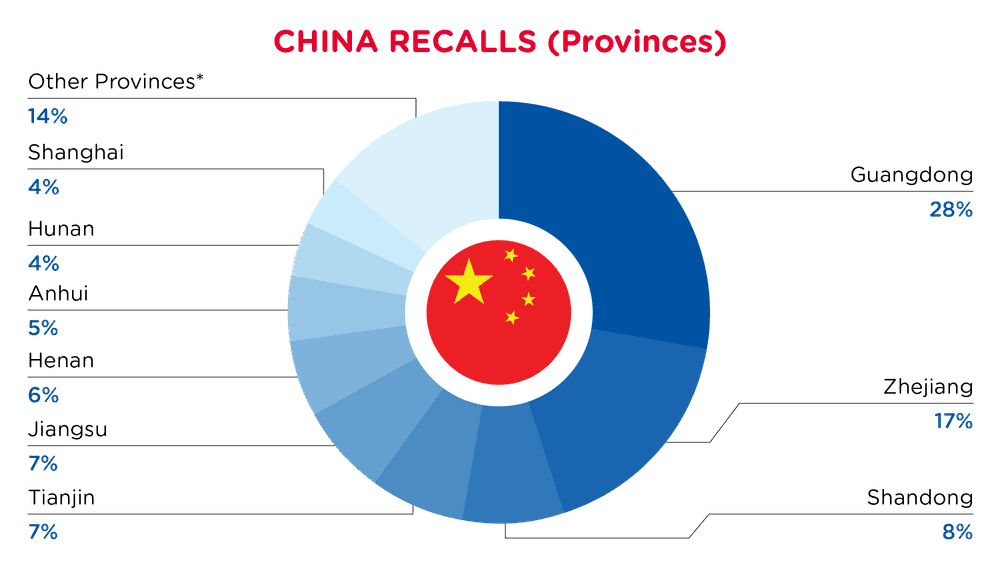abril 2025
Noticias de Norteamérica
In the US, when hazards are identified in consumer products, they will be recalled and published in the Consumer Product Safety Commission (CPSC) Recent Recalls on the CPSC website, which is updated daily. The US recalls from 01 March 2025 to 31 March 2025 are summarized below:

| Hazards | Frequency |
| Risk of Death | 7 |
| Injury Hazard | 7 |
| Burn Hazard | 6 |
| Fall Hazard | 5 |
| Fire Hazard | 5 |
| Laceration Hazard | 4 |
| Entrapment Hazard | 3 |
| Ingestion Hazard | 2 |
| Strangulation Hazard | 2 |
| Other Hazards* | 8 |
*Other Hazards include Crash Hazard, Entanglement Hazard, Choking Hazard, Chemical Hazard, Poisoning Hazard , Tip-Over Hazard, Impact Hazard, Swallowing Risk and Suffocation Hazard with a frequency of less than 2.

| Product Categories | Frequency |
| Sporting Goods / Equipment | 7 |
| Furniture | 6 |
| Electrical Appliances | 4 |
| Home Electrical Appliances | 2 |
| Toys and Childcare Products | 2 |
| Fabric / Textile / Garment / Home Textile | 2 |
| Computer / Audio / Video / Other Electronics & Accessories | 1 |
| Chemicals | 1 |
| Food Contact Material | 1 |
| Accessories | 1 |
| Household Items | 1 |
For a complete list click here
In Canada, when hazards are identified in consumer products, they will be recalled and published in the Recalls and Safety Alerts Database on the Health Canada website, which is updated daily. The Canada recalls from 01 March 2025 to 31 March 2025 are summarized below:

| Hazards | Frequency |
| Fire Hazard | 6 |
| Fall Hazard | 4 |
| Entrapment Hazard | 3 |
| Electric Shock Hazard | 3 |
| Injury Hazard | 3 |
| Burn Hazard | 2 |

| Product Categories | Frequency |
| Fabric / Textile / Garment / Home Textile | 3 |
| Electrical Appliances | 3 |
| Sporting Goods / Equipment | 3 |
| Toys and Childcare Products | 2 |
| Household Items | 2 |
| Chemicals | 1 |
| Home Electrical Appliances | 1 |
| Furniture | 1 |
| Footwear | 1 |
For a complete list click here
Noticias de Europa
The European Commission’s adoption of the new PFOS chemical group requirements will lead to amendments in the POPs Regulation (EU) 2019/1021. This new action will lower the permitted maximum level of PFOS as unintentional trace contaminants (UTC) in substances, mixtures and articles and will remove a specific exemption allowed in the EU, as it is no longer needed.
On 14 April 2025, relative to Persistent organic pollutants (POPs), and more specifically, Perfluorooctane sulfonic acid (PFOS), the European Commission adopted the draft act of PFOS which was proposed on 04 December 2023. This new action will lower the permitted maximum levels of PFOS as unintentional trace contaminants (UTC) in substances, mixtures and articles and remove a specific exemption in the European Union (EU), as it is no longer needed.
Findings show that PFOS uses are very similar to those of Perfluorooctanoic acid (PFOA). There is no indication that a limit for PFOS different from that for PFOA is needed.
The terminology used to identify PFOS and PFOA is different in the POPs Regulation, but the intention is, in both cases, to cover the whole group of substances including PFOS/PFOA, their salts, and the substances that degrade to PFOS and PFOA.
For these main reasons, the PFOS entry In Annex I, Part A of the POPs Regulation was modified (marked in red) as follows:
Comparison table prepared for quick review of areas of update:
| Annex I, Part A | Previous PFOS Entry | New PFOS Entry |
| Terminology | Perfluorooctane sulfonic acid and its derivatives (PFOS) C8F17SO2X (X = OH, Metal salt (O-M+), halide, amide, and other derivatives including polymers) | Perfluorooctane sulfonic acid (PFOS), its salts and PFOS-related compounds C8F17SO2X (X = OH, Metal salt (O-M+), halide, amide, and other derivatives including polymers) |
| Point 1 | in substances or in mixtures: PFOS ≤ 10 mg/kg (0,001 % by weight) | in substances, mixtures or in articles: PFOS or any of its salts ≤0,025 mg/kg (0,0000025 % by weight) |
| Point 2 | in semi-finished products or articles: PFOS < 0,1 % by weight for textiles or other coated materials PFOS < 1 μg/m2 | in substances, mixtures or in articles: Sum of PFOS-related compounds ≤1 mg/kg (0,0001 % by weight) |
| Point 4 | specific exemption of mist suppressant for non-decorative hard chromium (VI) plating in closed loop systems | Removed |
| Point 5 | information of analytical method | Removed |
Implementation:
This Regulation shall enter into force on the twentieth day following that of its publication in the Official Journal of the European Union.
Point 2 and point 3 of the Annex shall apply from 3 December 2025.
Affected parties should take necessary measures to comply with the PFOS amendments.
On 2 April 2025, The European Union Commission published the restriction of Polycyclic Aromatic Hydrocarbons in clay targets for shooting.
Polycyclic Aromatic Hydrocarbons (PAHs) are found in “Coal tar pitch, high temperature” (CTPHT) or similar petroleum products, which are used as a binder in the production of clay targets for shooting.
Following the shooting activities associated with the usage of clay targets, the corresponding emission of PAHs to the environment (and eventually to human beings) raised out the concern by the European Union (EU) Commission.
On 24 October 2024, the EU Commission published a proposal to restrict PAHs in clay targets for shooting, to address the environmental and human exposure hazards.
On 2 April 2025, this proposal became an official EU Regulation (EU) 2025/660.
The new EU regulation states the requirement of PAHs in clay targets for shooting (under a new entry 50a of REACH Annex XVII) as a concentration limit of 0.005% by weight of dry mass of the clay target, for the sum of 18 selected indicator PAHs species (as listed below). This concentration limit should NOT be exceeded in clay targets placed on the EU market.
Details of this PAHs restriction are summarized as below.
Requirement: Sum of PAHs ≤ 0.005% (By weight of dry mass of the clay target)
Effective Date: 22 April 2026
| Related Indictor PAHs | CAS Number | EC Number |
| Acenaphthene | 83-32-9 | 201-469-6 |
| Acenaphthylene | 208-96-8 | 205-917-1 |
| Anthracene | 120-12-7 | 204-371-1 |
| Benz[a]anthracene | 56-55-3 | 200-280-6 |
| Benzo[def]chrysene | 50-32-8 | 200-028-5 |
| Benzo[e]acephenanthrylene | 205-99-2 | 205-911-9 |
| Benzo[e]pyrene | 192-97-2 | 205-892-7 |
| Benzo[ghi]perylene | 191-24-2 | 205-883-8 |
| Benzo[j]fluoranthene | 205-82-3 | 205-910-3 |
| Benzo[k]fluoranthene | 207-08-9 | 205-916-6 |
| Chrysene | 218-01-9 | 205-923-4 |
| Dibenz[a,h]anthracene | 53-70-3 | 200-181-8 |
| Fluoranthene | 206-44-0 | 205-912-4 |
| Fluorene | 86-73-7 | 201-695-5 |
| Indeno[1,2,3-cd]pyrene | 193-39-5 | 205-893-2 |
| Naphthalene | 91-20-3 | 202-049-5 |
| Phenanthrene | 85-01-8 | 201-581-5 |
| Pyrene | 129-00-0 | 204-927-3 |
In Europe, when hazards are identified in non-food consumer products, the products will be recalled and published in the Safety Gate system, which is updated weekly. The European recalls from 01 March 2025 to 31 March 2025 are summarized below:

| Hazards | Frequency |
| Chemical Hazard | 228 |
| Injury Hazard | 33 |
| Electric Shock Hazard | 25 |
| Choking Hazard | 22 |
| Environmental Hazard | 21 |
| Fire Hazard | 20 |
| Burn Hazard | 8 |
| Suffocation Hazard | 7 |
| Other Hazards* | 13 |
*Other Hazards include Damage to Sight, Cut Hazard, Strangulation Hazard, Microbiological Hazard, Damage to Hearing and Drowning Hazard with a frequency of less than 5.

| Product Categories | Frequency |
| Bodycare / Cosmetics | 167 |
| Toys and Childcare Products | 53 |
| Electrical Appliances | 45 |
| Chemicals | 16 |
| Machinery | 13 |
| Jewelry | 11 |
| Fabric / Textile / Garment / Home Textile | 8 |
| Computer / Audio / Video / Other Electronics & Accessories | 6 |
| Home Electrical Appliances | 4 |
| Footwear | 4 |
| Other Categories* | 15 |
*Other Categories include Sporting Goods / Equipment, Outdoor Living Items, Furniture, Stationery, Tools and Hardware, Protective Equipment, Household Items and Car Accessories with a frequency of less than 4.

| Notifying Country | Frequency |
| Italy | 124 |
| United Kingdom in respect of Northern Ireland | 37 |
| Sweden | 26 |
| Poland | 25 |
| Hungary | 25 |
| France | 24 |
| Czechia | 22 |
| Germany | 17 |
| Finland | 9 |
| Cyprus | 5 |
| Luxembourg | 4 |
| Spain | 4 |
| Austria | 4 |
| Other Countries* | 16 |
*Other Countries include Belgium, Ireland, Lithuania, Malta, Norway, Iceland, Slovakia and Bulgaria with a frequency of less than 4.
For a complete list click here
Noticias de China
In China, when hazards are identified in consumer products, they will be recalled and published in the SAMR Defective Product Administrative Centre, which is updated daily. The China recalls from 01 March 2025 to 31 March 2025 are summarized below:

| Hazards | Frequency |
| Safety Risk Hazard | 26 |
| Electric Shock Hazard | 24 |
| Fire Hazard | 12 |
| Burn Hazard | 11 |
| Health Risk Hazard | 5 |
| Entanglement Hazard | 4 |
| Fall Hazard | 4 |
| Suffocation Hazard | 3 |
| Swallowing Risk | 3 |
| Other Hazards* | 11 |
*Other Hazards include Laceration Hazard, Skin Irritation Risk, Injury Hazard, Impact Hazard, Damage to Sight, Choking Hazard and Explosion Hazard with a frequency of less than 3.

| Product Categories | Frequency |
| Home Electrical Appliances | 20 |
| Fabric / Textile / Garment / Home Textile | 13 |
| Food Contact Material | 12 |
| Toys and Childcare Products | 9 |
| Electrical Appliances | 7 |
| Sporting Goods / Equipment | 7 |
| Chemicals | 5 |
| Protective Equipment | 4 |
| Stationery | 3 |
| Other Categories* | 3 |
*Other Categories include Accessories, Household Items and Furniture with a frequency of less than 3.

| Provinces | Frequency |
| Guangdong | 23 |
| Zhejiang | 14 |
| Shandong | 7 |
| Tianjin | 6 |
| Jiangsu | 6 |
| Henan | 5 |
| Anhui | 4 |
| Hunan | 3 |
| Shanghai | 3 |
| Other Provinces* | 12 |
*Other Provinces include Shaanxi, Sichuan, Inner Mongolia, Fujian, Chongqing, Hubei, Guizhou and Gansu with a frequency of less than 3.
For a complete list click here
Noticias de Australia/Nueva Zelanda
The mandatory standard for Consumer Goods (Infant Sleep Products) (https://www.legislation.gov.au/F2024L00891/latest/text) was updated on 26 February 2025 and is now referenced as Consumer Goods (Infant Sleep Products) Amendment Safety Standard 2025.
On 26 February 2025, the Australian government registered the updated Consumer Goods (Infant Sleep Products) Safety Standard. The intent of this standard is to reduce the risk of asphyxiation, suffocation, falls and entrapment to infants in relation to infant sleep products. The Safety Standard incorporates, by reference, voluntary Australian standards for household cots and folding cots as well as requirements from comparable overseas standards. Amendments listed in the updated standard include:
Schedule 1—Amendments
Consumer Goods (Infant Sleep Products) Safety Standard 2024
1. Section 6
Repeal the definition (including the note), substitute:
US CPSC Standard means the U.S. Consumer Product Safety Commission (16 C.F.R. Part 1241), Safety Standard for Crib Mattresses, published by the United States Consumer Product Safety Commission, as amended and in force or existing at the time when this instrument commences.
2. Paragraph 17(c)
Omit “United States Standard Consumer Safety Specification for Crib Mattresses,” substitute “US CPSC Standard”.
3. Paragraph 18(d)
Repeal the paragraph, substitute:
if the mattress is supplied with a household cot, the mattress must comply with paragraph 6.1(d) of the Australian/New Zealand Standard for household cots; and
4. At the end of section 18
Add:
(e) if the mattress is supplied with an infant sleep product that is not a household cot, the mattress must fit snugly with no gap between the mattress and the sides of the product.
5. Section 27
Repeal the section, substitute:
27 Small parts
Any component or part of an infant sleep product that can detach or be removed without the use of a tool, must not be able to fit entirely within a small parts cylinder that has a 31.7mm wide opening at the top, a cavity depth of the shorter side of 25.4mm and a cavity depth on the longer side of 57.1mm.
The Consumer Goods (Infant Sleep Products) Amendment Safety Standard 2025 enters into force on 19 January 2026.
In Australia, when hazards are identified in consumer products, they will be recalled and published in the Recalls and Safety Alerts Database on the Australian Competition & Consumer Commission website, which is updated daily. The Australia recalls from 01 March 2025 to 31 March 2025 are summarized below:

| Hazards | Frequency |
| Injury Hazard | 9 |
| Risk of Death | 7 |
| Choking Hazard | 3 |
| Electric Shock Hazard | 3 |
| Burn Hazard | 3 |
| Skin Irritation Risk | 2 |
| Fire Hazard | 2 |
| Swallowing Risk | 1 |
| Laceration Hazard | 1 |
| Fall Hazard | 1 |
| Suffocation Hazard | 1 |

| Product Categories | Frequency |
| Electrical Appliances | 4 |
| Toys and Childcare Products | 2 |
| Bodycare / Cosmetics | 1 |
| Protective Equipment | 1 |
| Home Electrical Appliances | 1 |
| Computer / Audio / Video / Other Electronics & Accessories | 1 |
| Fabric / Textile / Garment / Home Textile | 1 |
| Food Contact Material | 1 |
| Furniture | 1 |
For a complete list click here
Suscríbete a nuestras actualizaciones regulatorias
Anule su suscripción en cualquier momento. Lea nuestra política de privacidad.